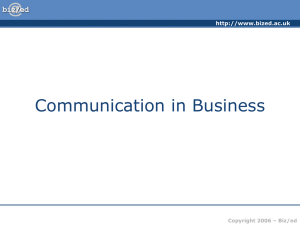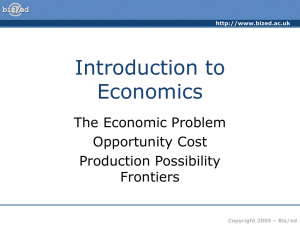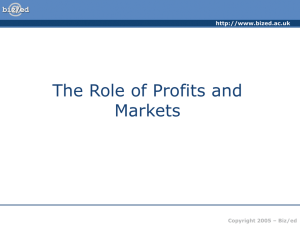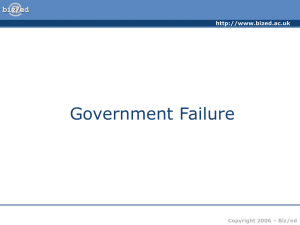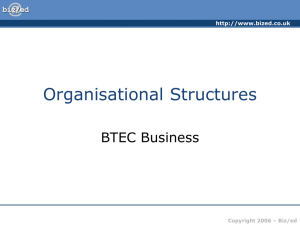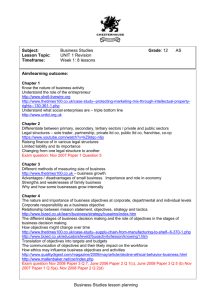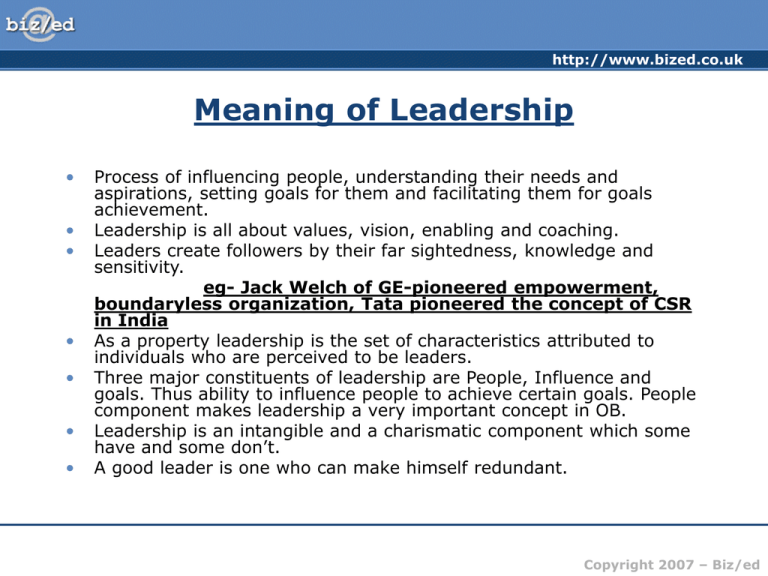
http://www.bized.co.uk
Meaning of Leadership
•
•
•
•
•
•
•
Process of influencing people, understanding their needs and
aspirations, setting goals for them and facilitating them for goals
achievement.
Leadership is all about values, vision, enabling and coaching.
Leaders create followers by their far sightedness, knowledge and
sensitivity.
eg- Jack Welch of GE-pioneered empowerment,
boundaryless organization, Tata pioneered the concept of CSR
in India
As a property leadership is the set of characteristics attributed to
individuals who are perceived to be leaders.
Three major constituents of leadership are People, Influence and
goals. Thus ability to influence people to achieve certain goals. People
component makes leadership a very important concept in OB.
Leadership is an intangible and a charismatic component which some
have and some don’t.
A good leader is one who can make himself redundant.
Copyright 2007 – Biz/ed
http://www.bized.co.uk
Leadership and Management
•
•
•
•
Manager
Creating an agenda- Planning
and Budgeting. Establishing
schedules of activities and
timetables.
Involving people- Recruitment,
selection and staffing the
organization structure.
Executing plans- Setting
standards, control and
feedback and monitoring
Outcome- Goal achievement,
good performance, satisfied
stakeholders.
Leader
•
•
•
•
Establishing directionDeveloping a vision of the
future and strategies needed to
achieve the vision.
Aligning peopleCommunicating the
organization’s goals to
employees and identify them
with individual goals.
Motivating and inspiringEnergizing people to
overcoming all barriers.
Producing change- Dramatic
changes which change the face
of the organization that
challenge the status quo.
Believing in the impossible
Copyright 2007 – Biz/ed
http://www.bized.co.uk
Leadership and Power
•
Legitimate power- Power granted through the organizational hierarchy. Formal in nature.
All managers have a legitimate power over their subordinates. But merely legitimate power
does not make a manager a leader.Other word for legitimate power is authority.
•
Reward power- Refers to the power to give or withhold rewards. Rewards like salary hikes,
promotions, recognition, praise.Greater the rewards a manager holds and greater the
importance of those for the employees more will be the manager’s reward power.
•
Coercive power- The power to force compliance by means of psychological, emotional and
physical threat. Coercion is limited to disciplinary actions, fines, lay offs, penalties, written
reprimands, firing etc. More the coercive power less the leader respect.
•
Referent power- Referent power is abstract in nature.It is based on identification, imitation,
loyalty and charisma.More the referent power more the status of a leader.
•
Expert power- Derived from information and expertise. The more important the information
and lesser the access that people have to it the more the expert power.
Copyright 2007 – Biz/ed
http://www.bized.co.uk
Approaches to leadership
•
Traits approach (1900-1950s)
1.
2.
Based on the assumption that leaders are born not made.
Focus was to identify the traits that distinguished leaders from
followers.
Differentiate leaders from non leaders
Identification of the characteristics, traits and attributes possessed
by leaders.
Traits are distinguishing personal characteristics of a person.
Motive was that if these set of traits were identified leaders could
be identified.
But the approach was not successful.
Ultimately categorization was done on the basis of physical,
personality, ability, task related, social and social backgrounds
traits.
3.
4.
5.
6.
7.
8.
Copyright 2007 – Biz/ed
http://www.bized.co.uk
Approaches to leadership contd..
•
1.
2.
3.
4.
5.
6.
7.
8.
Behavioral approach
Failure of traits studies led to the study of the behavioral approach
Objective was to find out that what are the behavioral patterns of
leaders.
How is the behavior of leaders different from that of non leaders.
Since behavior can be incorporated through training but traits
cannot.
How does the behavior of leaders result in the accomplishment of
the organizational goals.
Two major factors of behavioral variables were identified. They
were TASK ORIENTED BEHAVIOR and EMPLOYEE ORIENTED
BEHAVIOR.
Three universities were studying these two variables.
University of Michigan, Ohio State University and University of
Texas.
Copyright 2007 – Biz/ed
http://www.bized.co.uk
Approaches to leadership contd..
•
Situational or Contingency approach
1.
This model assumes that appropriate leader behavior varies from
situation to situation.
2.
Objective here was to identify the key situational factors which
determine appropriate leadership.
Avoid situations where you are likely to fail.
Match your leadership style with the appropriate situation.
Leaders must develop flexibility to change their style according to
the situation.
Fred Fiedler’s contingency theory, Hersey and Blanchard’s theory,
Leader member exchange theory and Path goal theory.
3.
4.
5.
6.
Copyright 2007 – Biz/ed
http://www.bized.co.uk
University of Michigan
•
•
•
•
•
•
•
•
•
•
•
•
•
Researchers were led by Rensis Likert.
Basically tried to contrast the behaviors of leaders with non leaders by interviewing
managers on one hand and workers on the other.
Took a one dimensional approach.
Identified two styles ie Job centered behavior and Employee centered behavior.
Classified leaders into effective and not effective.
Job centered leaders pay close attention to the subordinate’s work, explains the work
procedures and are keenly interested in performance so it comes under not effective
leader.
Employee centered leaders develop cohesive work group ensuring that employees are
satisfied with their jobs. Primary concern is welfare of subordinates. These leaders tend
to be effective.
Studied these two types of behavior on the same continuum and devided the continuum
from system 1 to system 4.
System1- Exploitative-Authoritative (PRODUCTION CENTERED)(NOT
PARTICIPATIVE)
System2- Benevolent-Authoritative
System3- Consultative
System4- Participative.(EMPLOYEE CENTERED)(HIGHLY PARTICIPATIVE)
Introduced the concept of participative leadership. Extension in the form of
Management by Objectives.
Copyright 2007 – Biz/ed
http://www.bized.co.uk
Ohio State Studies
•
•
Ralph Stogdill.
They identified two basic leadership behavioral variables or styles ie INITIATING
STRUCTURE and CONSIDERATION.
•
Leaders using Initiating structure fall under the category of Task oriented
leaders. They set clear goals for their subordinates. Clear lines of authority and
responsibility. Time to time monitoring and regular measurement of
performance. Corrective steps. Explicit schedules of work activities. Formal lines
of communication.
•
Leaders using Consideration fall under the category of people oriented leaders.
Believe in fostering informal relations. Personal touch in their dealings. Show
concern for the subordinate’s needs and aspirations. Establish warm, friendly
and supportive climate conducive to performance.
Difference between Ohio and Michigan- unlike Michigan, Ohio analysed leader
behavior on a two dimensional basis.
A leader could exhibit varying levels of Initiating structure and Consideration at
the same time.
Initially it was presumed that a combination of (HI,HC) yields best results but
later on evidence proved that performance depends on the interaction between
behavior and situation.
•
•
•
Copyright 2007 – Biz/ed
http://www.bized.co.uk
University of Texas
•
Given by Blake and Moutan through the explanation of Managerial
Grid.
•
Places every manager according to his behavior at some point on the
grid.
•
Two behavioral variables identified were Concern for Production
and Concern for People.
•
Concern for Production relates to Initiating structure and Job centered
and Concern for people relates to Consideration and Employee
centered respectively.
Copyright 2007 – Biz/ed
http://www.bized.co.uk
Blake and Mouton’s Managerial Grid
•
•
•
Draws on both studies to assess
leadership style
– “Concern for People” is
Consideration and EmployeeOrientation
– “Concern for Production” is
Initiating Structure and
Production-Orientation
Style is determined by position
on the graph
(1,1)- Impoverished
management. (9,1)- Authority
compliance.(1,9)-Country club.
(9,9)- Team management.
E X H I B I T 12-1
© 2009 Prentice-Hall Inc. All rights reserved.
12-10
Copyright 2007 – Biz/ed
http://www.bized.co.uk
Managerial Grid
•
(1,1)- IMPOVERISHED MANAGEMENT- Absence of management
philosophy. Delegate and dissappear.Manager exerts little effort
towards interpersonal relations or achievement of organizational
objectives.
•
(9,9)-TEAM MANAGEMENT- Considered the most effective style
where manager and organization members work together to
accomplish the goals.
•
(1,9)- COUNTRY CLUB- Where major focus is on building building
relationships and primary concern is people.But a low focus on tasks
may give questionable results.
•
(9,1)- AUTHORITY COMPLIANCE- Where efficiency of operations is
the dominating factor.Not much importance is attached to
people.Focus on efficiency including elimination of people wherever
necessary.
Copyright 2007 – Biz/ed
http://www.bized.co.uk
Approaches to leadership contd...
•
1.
Situational Approach
This theory believed that leaders are the product of a given
situation.
2.
Approach was to identify these situational factors which interact to
determine leader behavior.
3.
Appropriate leader behavior varies from situation to situation.
4.
Fred Fiedler’s LPC Theory.
5.
Hersey and Blanchard Theory.
6.
Robert House’s Path Goal Theory.
7.
Leader member exchange theory.
Copyright 2007 – Biz/ed
http://www.bized.co.uk
LPC Theory
•
•
•
•
•
•
•
•
Assumes that leader’s effectiveness is based on situational contingency which is
further the result of interaction between Favorableness of the situation and
leadership style.
The model suggests that leader effectiveness depends on whether the leader’s
natural leadership style is appropriately matched to the situation.
Identified two leadership styles- Task oriented and Relationship oriented
with the help of a questionnaire ie the Least Preferred Co worker (LPC).
Favorableness of the situation is determined by Leader-Member relation, Task
structure and Position Power.
Leader-Member relations- Refers to the relation between the leader and his
work group. If they have a high degree mutual trust, respect and confidence
situation is favorable.
Task structure- Extent to which the group’s task is well defined. Refers to the
clarity and ambiguity of operational procedures.
Position Power- Extent to which the leader has reward power.
Fiedler assumes that an individual’s leadership style is fixed, so if situation and
leader style don’t match either change the leader or change the situation.
Copyright 2007 – Biz/ed
http://www.bized.co.uk
Graphic Representation of Fiedler’s Model
Used to
determine
which type
of leader
to use in a
given
situation
E X H I B I T 12-2
© 2009 Prentice-Hall Inc. All rights reserved.
12-14
Copyright 2007 – Biz/ed
http://www.bized.co.uk
Copyright 2007 – Biz/ed
http://www.bized.co.uk
Hersey and Blanchard’s situational
leadership theory
•
•
•
•
•
•
•
•
•
•
Given by Paul Hersey and Kenneth Blanchard.
Introduced a new dimension of measuring leader effectiveness ie
follower’s readiness.
Readiness= Ability+Willingness
Essence was that leadership style gets influenced by the
characteristics of the group to be led.
Variables identified were Task behavior and Relationship
behavior.
Regardless of what leader does effectiveness depends on action of the
followers.
Follower readiness refers to the behavior of followers, their attitude
towards work and willingness to take responsibility.
Identified highly directive to a Laissez- faire approach.
Most effective leader behavior depends on the ability and willingness
level of the followers to assume responsibility.
R1 fits into S1, R2 into S2, R3 into S3 and R4 into S4.
Copyright 2007 – Biz/ed
http://www.bized.co.uk
Path goal theory
•
•
•
•
•
•
•
•
•
Given by Robert House.
Leaders need to provide information, support and resources to help followers
achieve the goals.
Help clarify the path and to make valued and desired rewards available at the
workplace.
Identified two variables- Leader Behavior and Situational factors.
Leader Behavior- Directive, Supportive, Participative and Achievement
Oriented.
Situational factors involve: Characteristics of subordinates and
Environmental characteristics.
Role of leader is to ensure that path to goals is clearly understood.
Rewards play a very important role.
Unlike Fiedler, House assumes that leaders are flexible and that the same
leader can display any or all these behaviors depending on the situation.
Copyright 2007 – Biz/ed
http://www.bized.co.uk
Path-Goal Model
•
Two classes of contingency variables:
– Environmental are outside of employee control
– Subordinate factors are internal to employees
E X H I B I T 12-4
© 2009 Prentice-Hall Inc. All rights reserved.
12-18
Copyright 2007 – Biz/ed
http://www.bized.co.uk
Leader Member Exchange Theory
• LMX Premise:
– Because of time pressures, leaders form a special relationship with a small
group of followers: the “in-group”
– This in-group is trusted and gets more time and attention from the leader
(more “exchanges”)
– All other followers are in the “out-group” and get less of the leader’s
attention and tend to have formal relationships with the leader (fewer
“exchanges”)
– Leaders pick group members early in the relationship
– In group members have higher level of satisfaction and performance.
– Each leader follower relationship is referred to as the “vertical dyad”.
Copyright 2007 – Biz/ed
http://www.bized.co.uk
LMX Model
E X H I B I T 12-3
© 2009 Prentice-Hall Inc. All rights reserved.
12-20
Copyright 2007 – Biz/ed

